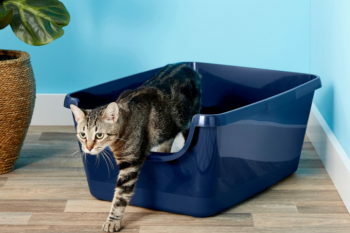How to Save Cats From Choking – The Heimlich Maneuver on Cats

Updated on
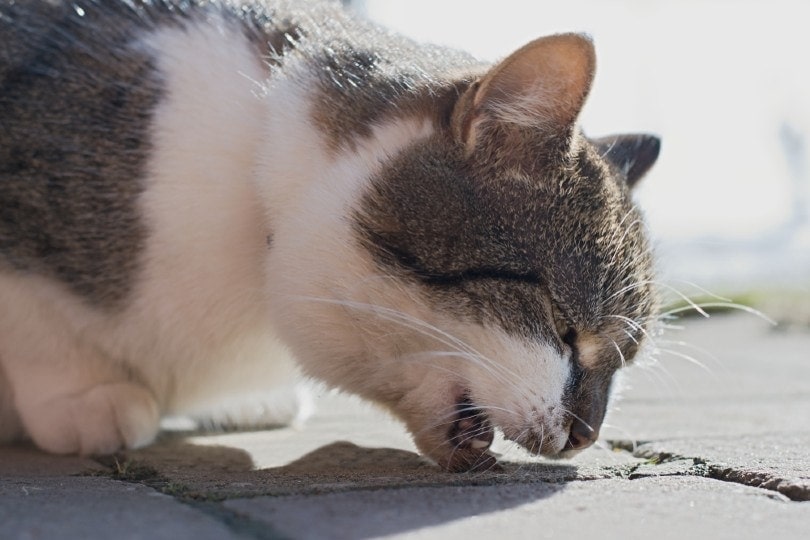
When you own a cat, you’ll likely encounter events that require knowledge of first aid for felines. One possible event is the risk of your cat choking while they’re playing or exploring. To save your cat’s life, you might need to use a modified Heimlich maneuver to dislodge the object while rushing your cat to the vet. This guide will tell you when, why, and how to perform the maneuver to save your cat.
What Are the Signs That Your Cat Is Choking?
Although it is possible, choking isn’t common in cats. Sometimes, your cat may mimic choking, and performing a Heimlich Maneuver in such a context will likely traumatize your cat. For this reason, it’s important to recognize the signs of your cat choking:
- Pawing at the mouth
- Coughing
- Gagging
- Labored or difficulty breathing
- Sudden Panic or Anxiety
- No airway noise
- Fainting
- Unconsciousness
If your cat has access to small toys like bells, strings, or was seen with something that could splinter easily, such as a cooked bone, then these could have caused the episode.
When Should You Use the Heimlich Maneuver on Cats?
The Heimlich maneuver should be used whenever you feel that your cat is choking, and may worsen unless you intervene. If your cat can’t breathe, start heading over to the nearest emergency veterinary clinic. While someone else is driving, you can try using the Heimlich Maneuver. It may also be helpful to learn how to perform CPR on cats in case your cat becomes unconscious.
Performing The Heimlich Maneuver on Cats: Step by Step
1. Stay Calm
When you realize that your cat is choking, it’s completely natural to freak out. However, you mustn’t let panic rule your actions. Take a deep breath and gather your thoughts.
While you need to work as quickly as possible to save your cat’s life, you’ll be much more helpful to your cat and more efficient if you keep your head and stay calm. The calmer you are, the more reassuring your presence will be to your cat too.
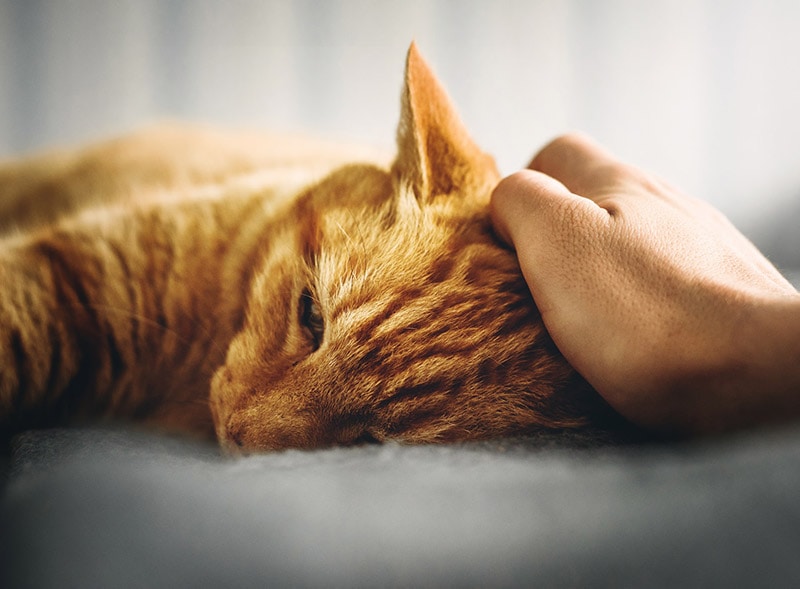
2. Wrap Your Cat in a Towel
To keep everyone safe, scoop up your cat and wrap it in a towel. Just make sure that your cat’s limbs can’t escape and scratch at you. It’s best to work on this with another individual, if possible. Regardless of if your cat is conscious or unconscious, start heading over to a veterinary clinic.
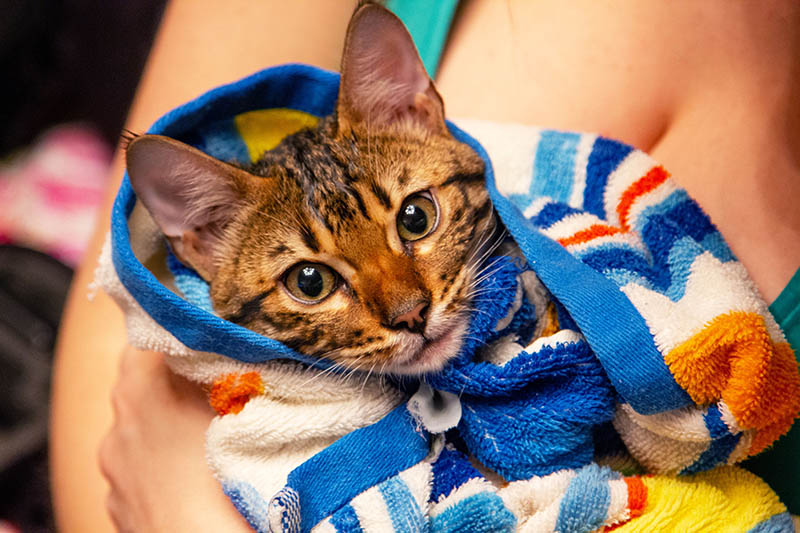
3. Open the Mouth and Look for Dislodged Objects
If you think your cat is choking, quickly open its mouth by placing your dominant hand above its head and your fingers near its jaws. Then, use your fingers to gently press down the lower jaw to open your cat’s mouth. Examine the color of its gums. If they are blue or pale, these are signs that your cat is struggling to breathe.
Check to see if you can see any objects lodged near the back of your cat’s throat. A flashlight can help give you a clearer view. If you can see the object, use your fingers or tongs to try to pull out the object. Be extremely careful when doing this, and make sure that you can keep your cat completely still so that you don’t accidentally lodge the object further down its throat.
It is very important to note that string or string-like objects, like a thistle lodged towards the back of the throat should NEVER be pulled, no matter how tempting it may seem UNLESS it moves very freely, like a piece of wet spaghetti. Pulling it in any other case may cause more harm than good.
4. Place Hands on Your Cat’s Back and Belly
If you don’t see an object, you should perform the Heimlich Maneuver. Lay your cat on their side and put your non-dominant hand on their belly, right below the ribcage. Use your dominant hand to support your cat.
5. Push In and Up
Once you’re in a stable position, push your non-dominant hand into your cat’s belly and push up. Your hand should be moving in a sharp in-and-up motion. Repeat this motion at least 5 times. Check your cat’s mouth to see if the object has dislodged. If it’s within reach, pull it out with your fingers or tongs. If the object hasn’t moved, try the Heimlich Maneuver again.
6. An Alternate Approach
Another way of doing this is to hold your cat in your arms, with its back resting against your chest, and their hind legs dangling freely. Ball your dominant hand into a tight fist, and place it into the palm of your non-dominant hand. The back of your non-dominant hand should rest just under your cat’s sternum, at the top of their belly.
Now, similar to the other technique, push your balled fist sharply into your other palm using a quick, inward and upward motion while you continue to support your cat. Administer at least 5 sharp, quick motions in rapid succession.
Open your cat’s mouth to see if any objects have dislodged. Remove any objects in the mouth. Close your cat’s mouth, and give them a few quick breaths through its nostrils.
As always, it is important to note that no matter how tempting it may seem to remove a string or string-like object lodged in the throat, you should NOT do so unless it is extremely loose and wiggles like a piece of wet spaghetti.
7. Go to the Emergency Vet
You should still take your cat to your veterinarian, even if you’re able to get the object out of your cat’s mouth. Oxygen deprivation can lead to serious consequences, so it’s important for your cat to get evaluated by a veterinarian to determine that it is in stable condition. Your veterinarian can perform other necessary treatments if your cat wasn’t able to breathe for an extended period.
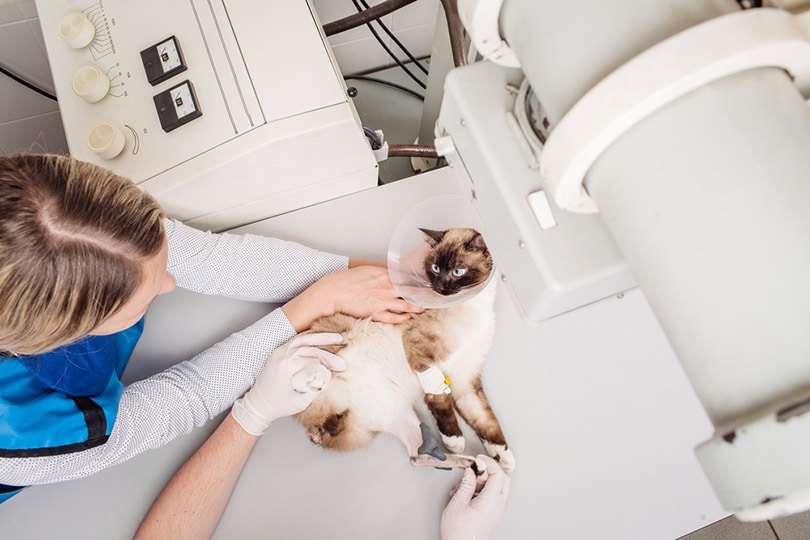
FAQ’s
What Causes Choking in Cats?
Cats are naturally inquisitive, and they’ll often use their mouths to explore the world around them. Unfortunately, their habit of chewing on objects to learn about them can lead to them accidentally swallowing things that they shouldn’t, causing them to choke.
- Small pompoms
- Bells
- Feathers from broken cat toys
- String
- Bone
How to Prevent Choking in Cats?
Monitoring your cat when they play and keeping any potential choking hazards far out of reach are the best ways to prevent choking. If one of your cat’s toys gets broken, remove the loose pieces or replace the toy as quickly as possible to ensure that your cat doesn’t accidentally swallow any pieces.
Watching your cat eat can help too, especially if your cat is known to have difficulty chewing. You’ll be able to intervene if they look like they’re struggling too much and to ensure that the food is a comfortable size for them to chew and swallow properly. Cats should not be fed cooked bones, as these can easily splinter and result in choking. They may also perforate your cat’s intestines or cause a blockage elsewhere along their digestive tract.
Conclusion
Though rare, cat can experience choking, even when it’s under the care of the most responsible cat owner. This is a life threatening situation that requires immediate response. The Heimlich Maneuver can be a life-saving technique that is worth knowing for any pet owner. It can be administered while the cat is rushed to the emergency vet for resuscitation. Being prepared for emergencies can help you feel calm and focused in the moment, and you’ll have an easier time giving your cat the help that it needs. Ensure that your cat doesn’t have access to objects that can easily dislodge and become a choking hazard, such as strings, thistle, fishing line, bones, small toys, bells, or toys that aren’t durable and can easily break when played with.
See also:
- How to Fatten Up a Cat: 8 Healthy Ways (Vet Answer)
- How to Tell if a Cat Has Internal Bleeding (Vet Answer)
Featured Image Credit: chie hidaka, Shutterstock






